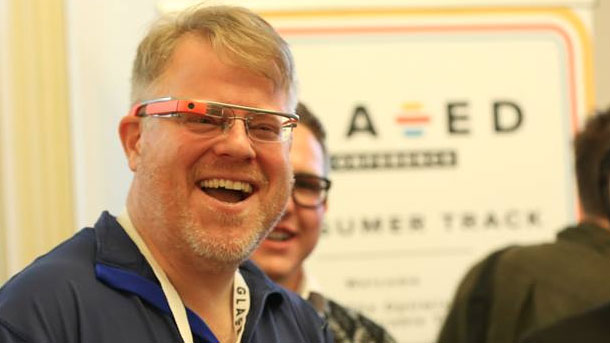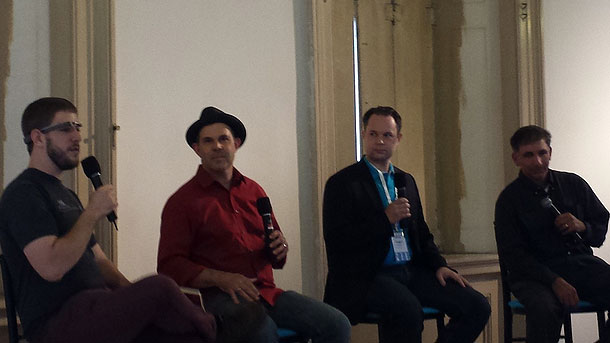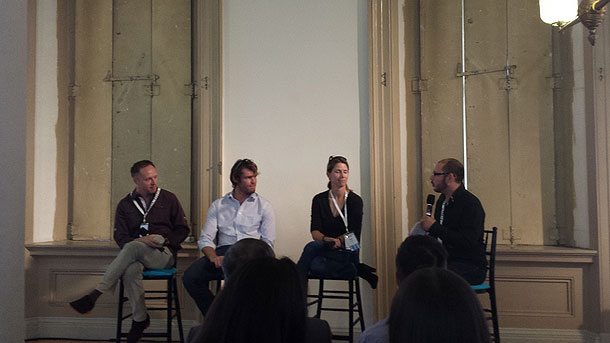The Wearable World
Laura Swallow reports from GLAZED Conference, San Francisco
It’s clear to many of us these days that wearables are the hot new thing in Silicon Valley. From the brightly colored Jawbone Up and Nike Fuel bands, to the hipster Pebble smart watch, wearables are everywhere. The biggest question on the minds of many is whether or not this “bubble” trend is something that will hit the mainstream with full force. Devices like Google Glass clearly became the darling of mainstream media, at least for a minute, but concept products in a nascent ecosystem will take some time to prove their usefulness and become widely adopted by the average consumer.
While veteran companies gear up to meet the hardware and software demands of the “connected things” market, consumers and enterprises alike are still testing the waters with their newly connected toys. I attended the Glazed Conference by Stained Glass Labs earlier this week to get a better look at what startups and old timers in this space think about the future of a wearable culture.
Will consumers take the plunge?
We are definitely smack dab in the middle of the smartphone revolution. For many of us, it’s difficult to remember what life was like in the flip phone era. One of the reasons that smartphones have become wildly successful is that they combine multiple functionalities into one easy to carry device. Suddenly our smartphones became our watches, our note takers, our access to the internet and jobs on the go.
Here’s the thing: Smartphones got so good at doing so many things, that they sometimes fall short of doing certain things REALLY well. We are all too familiar that the more apps we have running in the background, the more quickly our batteries die. Enter: wearables. Pull out some of that specialized functionality and free up some of the work your poor smartphone is constantly burdened with. The general sense I got during the conference is that the selling point of the wearable is to do one (or a few jobs) really well.
What seems to be the sweet spot for the wearables future is in providing a specialized form factor, limited functionality version of it’s bigger brother the smartphone, complete with GPS, connectivity and full app store for the everyday use of our favorite tools (like text, pictures, reminders). As such, the future success of smart things and wearables lies on the applications that will make them “can’t live withouts”.
Wearables will become the 4th screen with their own set of challenges such as screen real estate, sensors and battery life.
And, since many of these are worn daily, their design and beauty will be essential since if we wear them on our bodies, they become part of our fashion. Google Glass is definitely not the most fashionable looking accessory, but we’re early days, right? Time will tell, and the more engaging these devices become, the more we find value in them everyday, and humans become trained to adopt them into our lives, the stickier they will become.
Consumer vs Enterprise
While most of the action lies within the consumer market, there’s always the enterprise to contend with as well. Heads Up Displays (HUD) and augmented reality have been used for years by industries that need to train for certain skills needed in a variety of (often high stress) conditions, like the military, aerospace, and medical fields. It’s then natural to assume, that just as other enterprise-first industries like mapping and information discovery found their way to consumer so too will wearables and become widely adopted.
These devices may also begin to transform training for knowledge workers and older industries like medicine. While it takes time for these kinds of fields to adapt new technology, in the meantime traditional silicon valley companies focusing on chips, batteries, and display tech will continue to evolve to enable and support a new form of hardware companies popping up. Not only will wearables push the envelope with consumers, so too with all the companies supplying hardware components necessary to power the wearable age. Given that these large manufacturers have a choke hold on the devices industry, how are these guys interacting with smaller hardware companies that want to get into this space? Companies like Intel are working to ensure that they beef up their development tools.
Low power chipsets will also support newer devices as they are “trying to make it ‘lego simple’” for new hardware companies, as Steven Holmes, VP of the New Devices Group at Intel puts it. That will certainly be the key for ensuring the physical limitations with wearables become less and less of an issue. Extending battery life, advancements in sensor and connectivity technology (think GPS, accelerometers, Bluetooth Smart, WiFi and LTE) are just some of the things Broadcom, Intel and others are working on. That, and ensuring the proper developer tools are created to make those components come alive.
Enabling the Wearable Ecosystem (from left to Right): Jon Gottfriend, Evangelist Twilio, Steven Holmes, VP New Devices Group Intel, Tryggvi Lárusson, CTO & Co-Founder GreenQloud, Brian Bedrosian, Sr. Directore of Embedded Wireless Broadcom
And then there’s the cloud….ah yes, as we generate more and more information how will we keep track of it all. Wearables need the cloud, and actually live in the cloud, given their limited physical form factor. And what about all the information in my cloud? Can my wearables share information and provide analytics across all my various inputs? That’s yet to be seen, but once I learn my sleep patterns, is there any way I can combine that information with my travel information, diet, and vacation days? That kind of data analysis might not be too far away, but it’s clear that standardized APIs and some degree of common platforms will be required to enable this.
Watches and beyond, the ‘smart things’ device landscape
Beyond actual wearable devices and accessories, other “smart things” are beginning to make commonplace activities like turning on lights and heaters an action that just happens ambiently based on our preferences. The growing list of companies focusing on everyday pain points is showing us that there’s potentially a large market to update antiquated 1.0 solutions for our home.
“Smart plugs, thermometer and home access systems are changing the paradigms for home access and utility products”
said Jason Johnson, CEO of August Smart Locks. The key will be to convince consumers that these electronics REALLY DO make your life easier, by making mundane tasks like light switching and key turning a thing of the past. Building a hardware company is tough, however, and startups in this space face a lot of additional challenges and cost to be successful. Those that do make it will pave the way for the next generation of smart homes.
Bill Gates’ “home of the future” is not so far from reality in your own home as these devices aim to fix real pain points and enable a fully customized home.
Wearable Home Panel (left to right): Jason Johnson, CEO August, Chris Hughes, Developer The Plant, Trae Vasallo, Partner KPCB, Redg Snodgrass, Founder Stained Glass Labs
App, App, and Away!
One thing is clear, it will be essential that the developer community buys in to create an ecosystem of useful apps and tools that leverage this new hardware set. iPhone’s success was in part largely due to the numerous applications that quickly became available on their hardware platform. Consumers found endless uses for their new iPhone gadget and overnight it became the cure for everything from boredom to planning a wedding. If wearables are to succeed, a similar kind of gravity must sway towards these tiny, super specialized devices. Figuring out how communications, multimedia, and social will fit into the wearable world is still an open question and newly mobile activities such as shopping, search, and gaming will also need to find a home on these tiny machines.
It’s a bit of a chicken & egg, in that some argue waiting for Apple is the way to go, for they will surely focus on design and likeability, provide valuable software development platforms, and clearly have the (current) love from the mass market. Time will only tell if this new industry will generate enough monetization opportunities for the stakeholders required to make it flourish. There’s a lot of ground to cover and a lot of advancement to be made, but for now all things point towards a bright world for our everything connected world.
Additional news coverage from ABC News
Article and panel photos by: Laura Swallow @techchiq
Laura is an MLOVE speaker alumni and Associate Director, New Business Ventures at Verizon Wireless. She has just been nominated to be included in the 2013 AlwaysON 100 Mobile Power Players – this guest post is her personal view.
Headline Photo by Michael O’Donnell – with permission by Glazed Conference
MORE IN WEARABLES:
Stained Glass Labs presents Wearable Wonderland, a holiday party to celebrate the Wearable Tech and Internet of Things ecosystem and a charity!
Wearable Wonderland will highlight a top-tier panel of innovative Tech CEO’s, honor the top 100 executives within the Wearable and IOT space, and feature over 20+ models fashioning the coolest wearable tech devices of 2013.
Wearable Wonderland presented by Stained Glass Labs will take place Saturday, December 7, 2013, at 7:00pm PST. Tickets available at Eventbrite and accessible with the password wonderland13.
































